

How the turtle got its shell. This Bumpy-Faced Reptile Ruled the Prehistoric Desert. An artist’s rendering of Bunostegos, a plant-eating reptile that lived in the deserts of Pangea some 266 to 252 million years ago.
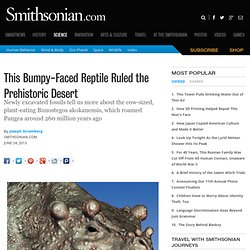
Image via Marc Boulay If, somehow, you were magically transported back 255 million years in time to the middle of the vast desert that likely lay at the center of the supercontinent Pangea, you might come face to face with a cow-sized reptile called Bunostegos akokanensis. But no need to fear! Despite its frighteningly bumpy-faced appearance, the creature was a confirmed vegetarian. Ongoing excavations in Niger and elsewhere in Africa are allowing paleontologists to learn more about the extinct animals that roamed this ancient desert, and several newly discovered Bunostegos skull fossils provides one of the first looks at this admittedly unusual-looking creature.
One of three Bunostegos skull fossils recently excavated and analyzed. This sort of analysis also helps researchers make broader conclusions about the environment Bunostegos lived in. Pareiasaur. Description[edit] Pareiasaurs ranged in size from 60 to 300 centimetres (2.0 to 9.8 ft) long, and may have weighed up to 600 kilograms (1,300 lb).
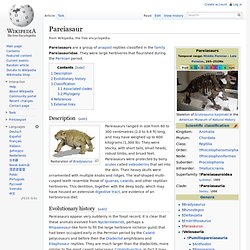
They were stocky, with short tails, small heads, robust limbs, and broad feet. Pareiasaurs were protected by bony scutes called osteoderms that set into the skin. Their heavy skulls were ornamented with multiple knobs and ridges. The leaf-shaped multi-cusped teeth resemble those of iguanas, caseids, and other reptilian herbivores. Evolutionary history[edit] Pareiasaurs appear very suddenly in the fossil record. Classification[edit] Associated clades[edit] Hallucicrania (Lee 1995), The clade Hallucicrania was coined by MSY Lee, for Lanthanosuchidae + (Pareiasauridae + Testudines). Pareiasauroidea (Nopsca, 1928), The clade Pareiasauroidea (as opposed to the superfamily or suborder Pareiasauroidea) was used by Lee 1995 for Pareiasauridae + Sclerosaurus. Phylogeny[edit] Below is a cladogram from Tsuji et al. (2013):[4] References[edit] Carroll, R.
Ancient Shark With Spiral-Toothed Jaw Studied In Detail. February 27, 2013 Image Caption: Artistic conception of Helicoprion by illustrator and artist Ray Troll.

Credit: Ray Troll/ISU Brett Smith for redOrbit.com – Your Universe Online. The Paleontology Portal: The Permian. World Paleogeography: Around the world, the continental collisions begun in the Carboniferous continued into the Permian.
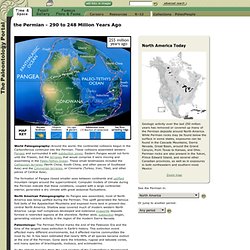
These collisions assembled western Pangea and surrounded it with subduction zones. Eastern Pangea would not form until the Triassic, but the terranes that would comprise it were moving and assembling in the Paleo-Tethys Ocean. These small landmasses included the Cathaysian terranes (North China, South China, and other pieces of Southeast Asia) and the Cimmerian terranes, or Cimmeria (Turkey, Iran, Tibet, and other pieces of Central Asia). Brule Trackways of Nova Scotia. Fossils of Brule: Identifying the Trackways.
The Permian Period. Online exhibits : Geologic time scale : Paleozoic Era.
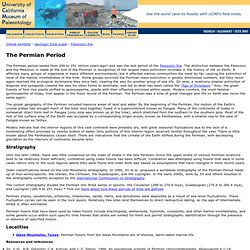
Glass Mountains, Texas. The Glass Mountains are located in southwestern Texas, U.S.A., at approximately 30°30' N and 103° W, about 370 km (about 225 mi) ESE of El Paso, Texas, in an area marked by the towns of Fort Stockton and Marathon.
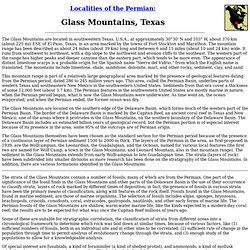
The mountain range has been described as about 24 miles (about 39 km) long and between 6 and 15 miles (about 10 and 24 km) wide. Permian mass extinction triggered by humble microbe - life - 14 December 2012. AROUND 251 million years ago, over 90 per cent of the species on Earth suddenly went extinct.

Their killer may not have been a devastating meteorite or a catastrophic volcanic eruption, but a humble microbe. The prevailing theory is that the mass extinction at the end of the Permian period was triggered by volcanic eruptions over a vast area of what is now Siberia. This led, among other things, to a dramatic rise in greenhouse gas emissions. But the scenario just doesn't fit the facts, says Daniel Rothman of the Massachusetts Institute of Technology. From his analysis of an end-Permian sediment sample from China, Rothman says carbon levels surged much too quickly for geological processes to be at work. Microbes can generate carbon compounds that fast, though. But Methanosarcina needs large amounts of nickel to produce methane quickly. Other geologists remain to be convinced. More From New Scientist Computer sleuths try to crack Pioneer anomaly (New Scientist)
Permian Extinction Information, Prehistoric Facts. The Permian period, which ended in the largest mass extinction the Earth has ever known, began about 299 million years ago.
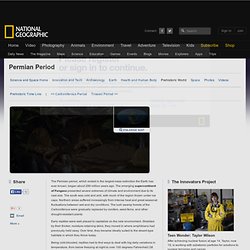
The emerging supercontinent of Pangaea presented severe extremes of climate and environment due to its vast size. The south was cold and arid, with much of the region frozen under ice caps. Northern areas suffered increasingly from intense heat and great seasonal fluctuations between wet and dry conditions. The lush swamp forests of the Carboniferous were gradually replaced by conifers, seed ferns, and other drought-resistant plants. Early reptiles were well placed to capitalize on the new environment. Being cold-blooded, reptiles had to find ways to deal with big daily variations in temperature, from below freezing at night to over 100 degrees Fahrenheit (38 degrees Celsius) during the day.